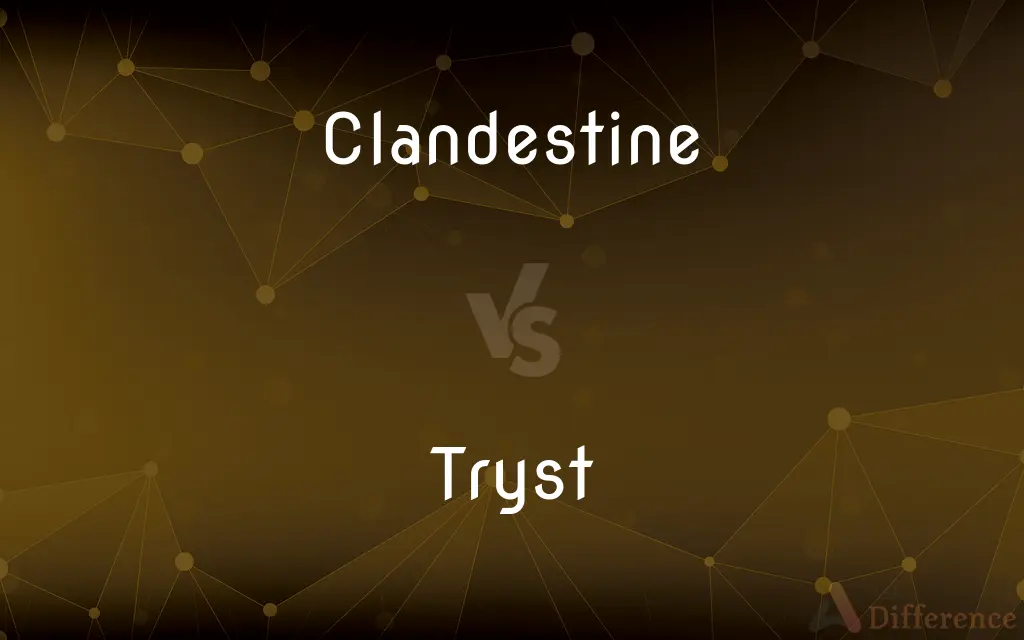Clandestine vs. Tryst — What's the Difference?
By Fiza Rafique & Maham Liaqat — Updated on April 4, 2024
Clandestine describes secretive activities, while tryst refers to a secret meeting, often between lovers.

Difference Between Clandestine and Tryst
Table of Contents
ADVERTISEMENT
Key Differences
Clandestine is an adjective used to describe actions, activities, or operations that are kept secret or done in a private, often illicit way, usually to conceal an illicit or improper purpose. The term implies a need for secrecy, either due to the sensitive nature of the activities or to avoid detection and scrutiny. On the other hand, tryst is a noun that specifically denotes a private, secret meeting between lovers. While a tryst is inherently clandestine in nature, focusing on the secrecy of romantic rendezvous, not all clandestine activities are trysts.
Clandestine activities encompass a wide range of actions beyond romantic encounters, including secret spy operations, undercover investigations, and private business meetings meant to be hidden from the public eye or certain parties. Trysts, however, are exclusively personal and intimate, involving a meeting between lovers that is not intended to be known by others, often due to societal, personal, or situational constraints.
The motivation behind clandestine activities is varied, ranging from the need to protect personal or national security to the desire to conduct activities considered unethical, illegal, or socially unacceptable. In contrast, the motivation for a tryst is primarily driven by desire, affection, or love, coupled with a need for discretion due to existing social, marital, or professional barriers.
In terms of emotional connotations, clandestine activities can evoke feelings of excitement, danger, and intrigue, as well as fear, anxiety, and guilt, depending on the context and the individuals involved. Trysts, by their nature, also evoke strong emotions, including passion, longing, and possibly guilt or fear of discovery, reflecting the complex dynamics of secret romantic relationships.
While clandestine is a broader term that can apply to any secret activity, tryst specifically refers to the act of meeting secretly, especially with romantic connotations. This distinction highlights the specialized nature of trysts within the wider context of clandestine activities.
ADVERTISEMENT
Comparison Chart
Definition
Secretive, hidden activities
Secret meeting between lovers
Context
Broad, includes any secret activity
Specifically romantic or intimate encounters
Motivation
Varied: security, privacy, illicit purposes
Romantic desire, need for discretion
Emotional Connotations
Excitement, danger, guilt
Passion, longing, guilt, fear of discovery
Scope
Any secret operation or action
Personal, intimate meetings
Compare with Definitions
Clandestine
Characterized by, done in, or executed with secrecy or concealment.
Clandestine activities often involve espionage or covert operations.
Tryst
A private, romantic rendezvous between lovers.
The two lovers arranged a tryst in the secluded garden.
Clandestine
Kept secret or done secretively, especially when illicit.
They operated a clandestine radio station during the war.
Tryst
An appointed meeting or meeting place, specifically for lovers.
The old oak tree was their usual tryst.
Clandestine
Involving secrecy or concealment as a means to an end.
The clandestine nature of the meetings raised suspicions.
Tryst
Engagement in a relationship or affair, especially secretively.
The novel revolves around the protagonists' illicit tryst.
Clandestine
Not officially acknowledged or displayed.
The clandestine support from the ally remained a tightly kept secret.
Tryst
A secret meeting, especially between lovers, by agreement.
Their tryst was discovered, leading to a scandal.
Clandestine
Hidden from view; private and not to be disclosed.
The government agent was involved in clandestine operations.
Tryst
A mutually agreed upon time and place for meeting, often secretive.
They kept their tryst despite the risks involved.
Clandestine
Kept or done in secret, often to conceal an illicit or improper purpose.
Tryst
A prearranged meeting or assignation, now especially between lovers to meet at a specific place and time.
Clandestine
Done or kept in secret, sometimes to conceal an illicit or improper purpose.
Clandestine military operations
Tryst
An agreement between lovers to meet at a certain time and place.
Clandestine
Not recognized as a regular member.
Tryst
A usually private meeting or meeting place that has been agreed on by lovers.
Clandestine
Conducted with secrecy; withdrawn from public notice, usually for an evil purpose; kept secret; hidden; private; underhand; as, a clandestine marriage.
Tryst
To keep a tryst.
Clandestine
Conducted with or marked by hidden aims or methods;
Clandestine intelligence operations
Cloak-and-dagger activities behind enemy lines
Hole-and-corner intrigue
Secret missions
A secret agent
Secret sales of arms
Surreptitious mobilization of troops
An undercover investigation
Underground resistance
Tryst
(obsolete) A mutual agreement, a covenant.
Tryst
A market fair, especially a recurring one held on a schedule, where livestock sales took place.
Tryst
(intransitive) To make a tryst; to agree to meet at a place.
Tryst
(transitive) To arrange or appoint (a meeting time etc.).
Tryst
(intransitive) To keep a tryst, to meet at an agreed place and time.
Tryst
Trust.
Tryst
An appointment to meet; also, an appointed place or time of meeting; as, to keep tryst; to break tryst.
The tenderest-hearted maidThat ever bided tryst at village stile.
Tryst
To trust.
Tryst
To agree with to meet at a certain place; to make an appointment with.
Tryst
To mutually agree to meet at a certain place.
Tryst
A secret rendezvous (especially between lovers)
Common Curiosities
How do clandestine activities affect relationships?
Clandestine activities can strain relationships due to the secrecy and potential deceit involved, leading to trust issues.
What makes an activity clandestine?
An activity is clandestine if it's carried out in secrecy, especially to conceal an illicit or improper purpose.
Can a business meeting be a tryst?
No, a tryst specifically refers to a secret meeting between lovers, not business-related meetings.
Why are some activities done clandestinely?
Activities are done clandestinely to avoid detection, scrutiny, or to protect the privacy or security of the individuals involved.
Can a tryst become public knowledge without repercussions?
Depending on the context and societal norms, a tryst becoming public can have varied repercussions, from minimal to significant social, professional, or legal consequences.
Is a tryst always romantic?
Yes, a tryst is inherently romantic or intimate, involving a secret meeting between lovers.
Are all romantic meetings considered trysts?
Not all romantic meetings are trysts; the term tryst implies secrecy and an agreement to meet privately, often with societal, personal, or situational constraints.
How do cultural perceptions of clandestine activities and trysts vary?
Cultural perceptions can vary widely, with some cultures viewing them with tolerance or romanticism, while others may see them as unethical or morally objectionable.
Is it possible for a tryst to be part of a clandestine activity?
Yes, a tryst can be a component of clandestine activities, especially if it's part of a larger scheme of secret operations or actions.
How do clandestine activities and trysts impact society?
They can have a wide range of impacts, from influencing political landscapes to affecting social norms and personal relationships.
What's the difference in emotion between clandestine and tryst?
Clandestine activities evoke a range of emotions from excitement to guilt, while trysts specifically evoke emotions related to romantic desire and the potential consequences of discovery.
How do individuals involved in clandestine activities communicate?
They often use coded messages, secure channels, or indirect methods to maintain secrecy and avoid detection.
What historical examples are there of clandestine activities?
Historical examples include secret resistance movements, undercover operations during wars, and covert political negotiations.
Can technology facilitate clandestine activities or trysts?
Yes, technology can facilitate both by providing platforms for secret communication and planning, though it also raises risks of detection through digital footprints.
Share Your Discovery

Previous Comparison
Sponsorer vs. Sponsor
Next Comparison
Radiant vs. BrightAuthor Spotlight
Written by
Fiza RafiqueFiza Rafique is a skilled content writer at AskDifference.com, where she meticulously refines and enhances written pieces. Drawing from her vast editorial expertise, Fiza ensures clarity, accuracy, and precision in every article. Passionate about language, she continually seeks to elevate the quality of content for readers worldwide.
Co-written by
Maham Liaqat














































